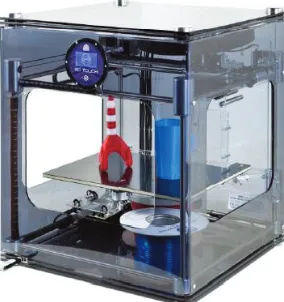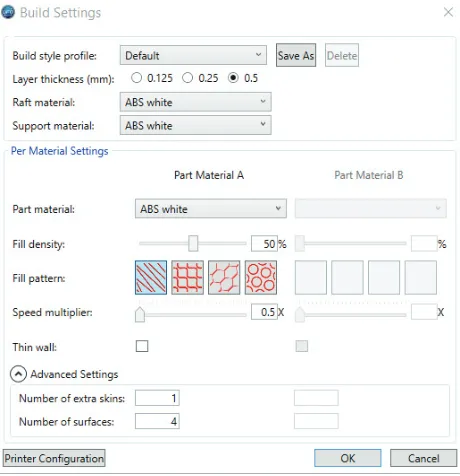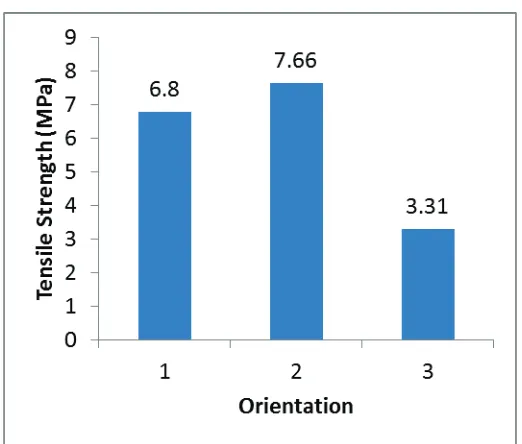The effect of orientation difference in fused deposition modeling of ABS polymer on
the processing time, dimension accuracy, and strength
Yopi Y. Tanoto, Juliana Anggono, Ian H. Siahaan, and Wesley Budiman
Citation: 1788, 030051 (2017); doi: 10.1063/1.4968304 View online: http://dx.doi.org/10.1063/1.4968304
View Table of Contents: http://aip.scitation.org/toc/apc/1788/1
The Effect of Orientation Difference in Fused Deposition
Modeling of ABS Polymer on the Processing Time,
Dimension Accuracy, and Strength
Yopi Y. Tanoto
1,a),
Juliana Anggono
1, Ian H. Siahaan
1and Wesley Budiman
11Mechanical Engineering Department – Petra Christian University, Surabaya 60236, Indonesia
a)Corresponding author: [email protected]
Abstract. There are several parameters that must be set before manufacturing a product using 3D printing. These parameters include the orientation deposition of that product, type of material, form fill, fill density, and other parameters. The finished product of 3D printing has some responses that can be observed, measured, and tested. Some of those responses are the processing time, the dimensions of the end product, its surface roughness and the mechanical properties, i.e. its yield strength, ultimate tensile strength, and impact resistance. This research was conducted to study the relationship between process parameters of 3D printing machine using a technology of fused deposition modeling (FDM) and the generated responses. The material used was ABS plastic that was commonly used in the industry. Understanding the relationship between the parameters and the responses thus the resulting product can be manufactured to meet the user needs. Three different orientations in depositing the ABS polymer named XY( first orientation), YX (second orientation), and ZX (third orientation) were studied. Processing time, dimensional accuracy, and the product strength were the responses that were measured and tested. The study reports that the printing process with third orientation was the fastest printing process with the processing time 2432 seconds followed by orientation 1 and 2 with a processing time of 2688 and 2780 seconds respectively. Dimension accuracy was also measured from the width and the length of gauge area of tensile test specimens printed in comparison with the dimensions required by ASTM 638-02. It was found that the smallest difference was in thickness dimension, i.e. 0.1 mm thicker in printed sample using second orientation than as required by the standard. The smallest thickness deviation from the standard was measured in width dimension of a sample printed using first orientation (0.13 mm). As with the length dimension, the closest dimension to the standard was resulted from the third orientation product, i.e 0.2 mm. Tensile test done on all the specimens produced with those three orientations shows that the highest tensile strength was obtained in sample from second orientation deposition, i.e. 7.66 MPa followed by the first and third orientations products, i.e. 6.8 MPa and 3.31 MPa, respectively.
INTRODUCTION
Product cost, quality, and time to market are the three effectiveness criteria for the design process [1]. The development of the technology of rapid prototyping (RP) which uses 3D printing technology makes the design or the product development process become faster. RP is a technique that can be used to create a data computer aided design (CAD) into 3D objects with additive manufacturing or 3D printing technology [2]. There are many types of RP technologies, such as stereolithography, fused deposition modeling, laminated object manufacturing, selective laser sintering, etc. From the various types of technologies, RP is the most commonly used in fused deposition modeling (FDM). In FDM, a filament extruded through a heated die [3].
orientation on PLA had a small deviation dimension compared with the ABS [4]. Other research groups like Galeta
et al. studied the effect of printing process parameters on the production process of 3D printing products [5]. Factors
studied were the orientation of the object, layer thickness, and the type of infiltrant. Lužanin, et al. studied the effect of layer thickness, deposition angle, and the infill shape on the deflection force at FDM [6].
A research work about parameters that are affecting the mechanical properties in FDM 3D printing product is also important because FDM is the most common 3D printer that can be used from the household to the industrial scale. Today the product of 3D printing is not only as a prototype but also as an end product. From previous research, it was found that the differences of orientations are affecting the processing time and quality, but the vertical (third) orientation and tensile strength response ware not observed. Therefore, this research was carried out to investigate the effect of object orientation during FDM process on the processing time, dimensional accuracy, and the tensile strength of the products.
EXPERIMENTAL METHOD
Preparation of Material, Setting and Printing Process
Materials used in this research was 1 kg BFB (Bits from Bytes) ABS polymer filament. In 3D printing process, ABS is a popular plastic that has been used to make all sorts of home goods and toys [7]. 3D engine printer used was BFB 3D Touch Double (Fig. 1). FDM printing process produced three specimens for each orientation (Fig. 2). The dimensions of the specimens were determined in accordance with ASTM D638-02 [8]. Specimens drawing was created using CAD software. The CAD files were saved in. stl format which then was imported into 3D Printing software, namely AXON v2. Axon software is processed the model specimen printing process according to the parameters input (Fig. 3). During the printing, the processing time was recorded using a stopwatch. The starting time was recorded when an extruder began the printing process (extruder began to extrude the material), and the recording ended when the extruder finished the printing process.
Layer thickness means the thickness of each layer printed. The thinner the layer the smoother the surface will be. However, the thicker the layer will make the printing time faster.
Specimen Characterization
Characteristics of the printed specimens that were measured and tested were the dimensional accuracy of all specimens produced with different deposition orientations and their tensile strength. Specimen dimensions, namely the length, width, and thickness were measured using a caliper with an accuracy of 0.05 mm. Before performing the tensile test, all specimens were prepared by grinding their surface with the silicon carbide paper with a surface finish surface using grade 1500. Tensile test machine used was Autograph AG 10TE Shimadzu with a capacity of 10 kN.
(a) (b) (c)
FIGURE 2. (a) First orientation (b) Second Orientation (c) Third Orientation
FIGURE 3. AXON Built Setting Interface
RESULTS AND DISCUSSION
Influence of Object Orientation on Dimensional Accuracy
FIGURE 4. Specimen dimensions printed in a different orientation (a) thickness (b) width and (c) length.
Influence of Object Orientation On Processing Time
FIGURE 5. Processing Time Needed In Different Orientation
FIGURE 6. Raft and Support in Specimen at (a) First Orientation (b) Third Orientation (c) Second Orientation
Influence of Object Orientation on Tensile Strength
FIGURE 7. Tensile Strength Obtained with Different Orientation
FIGURE 8. Illustration of gage section under a tensile load (a) first orientation (b) second orientation.
CONCLUSION
From the experiments and tests performed, it can be concluded that the third orientation has the fastest processing time, i.e., 2432 seconds because during the printing process, support was not needed and it only used the smallest raft. In dimensional accuracy, each orientation has the smallest difference in dimension of its own in comparison to the required dimension by ASTM D638-02. The highest tensile strength was identified with the product printed with a second orientation (7.66 MPa), and the third orientation product has the smallest tensile strength, i.e. 3.31 MPa. For the application, the operator can set the orientation based on the required response, for example, for faster processing time, third orientation should be set.
ACKNOWLEDGEMENTS
REFERENCES
1. D.G. Ulman, The Mechanical Design Process (4th ed.). Singapore: McGraw-Hill.Inc. (2010)
2. S. Kalpakjian and S.R. Schmid, Manufacturing Engineering and Technology, Chicago: Pearson. (2009).
3. J. Lesko, Industrial Design: Materials and Manufacturing Guide, New Jersey, John WIley & Sons Inc. (2011).
4. S. Lubis and D. Sutanto, Pengaturan Orientasi Posisi Obyek pada Proses Rapid prototyping Menggunakan 3D Printer Terhadap Waktu Proses dan Kwalitas Produk. Jurnal Teknik Mesin, Vol. 15, 27-34. (2014).
5. T. Galeta, I. Kladaric, and M. Karakasic, Original Scientific Article 47, 781-788 (2013). 6. O. Lužanin, D. Movrin and M. Plančak, J. Technol. Plast. 39, 49-58 (2014).
7. Budmen, I., & Rotolo, A. The book on 3D Printing. North Charleston: CreateSpace Independent Publishing Platform. (2013).




